HNN215 Quality Use of Medicines: A Case Study on Mr. Michael Coleman
VerifiedAdded on 2023/04/11
|10
|2304
|229
Case Study
AI Summary
This case study examines the medication management of Mr. Michael Coleman, focusing on the risks associated with his prescribed medications, including GI bleeding and hypotension. It identifies potential strategies nurses can implement to prevent or manage these risks, emphasizing the importance of medication administration rights, double checks, medication reviews, and patient education. Furthermore, it discusses factors contributing to Mr. Coleman's decreased adherence to his medication regime, such as lack of knowledge, perceived lack of improvement, and frequent hospitalizations. The case study also highlights key education points for nurses to provide regarding Atorvastatin, including monitoring therapeutic effectiveness and potential adverse effects. This analysis underscores the complex considerations in managing patients with multiple health conditions and medications, with the goal of optimizing patient safety and adherence. Desklib provides solved assignments and study resources to aid students in similar case studies.
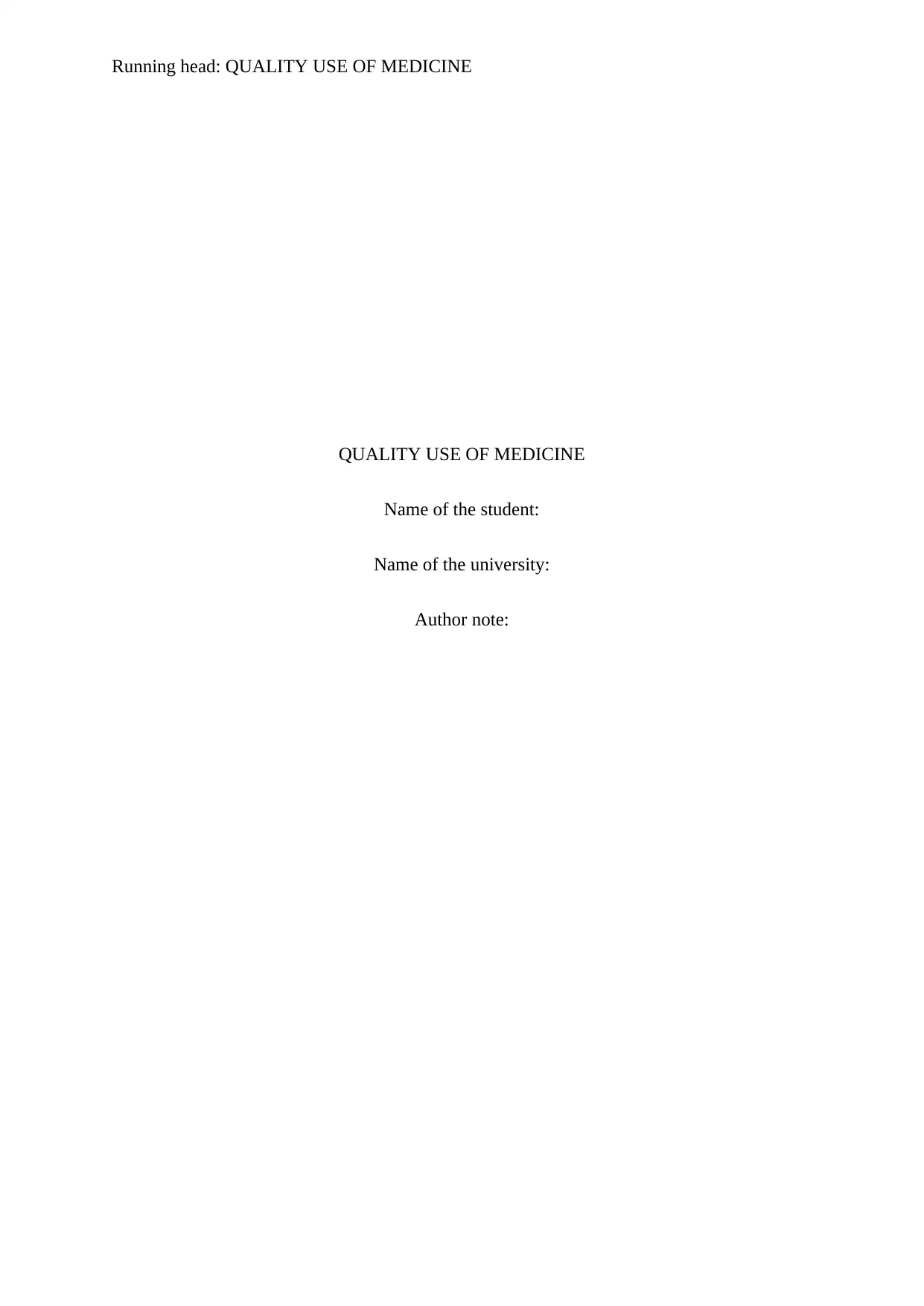
Running head: QUALITY USE OF MEDICINE
QUALITY USE OF MEDICINE
Name of the student:
Name of the university:
Author note:
QUALITY USE OF MEDICINE
Name of the student:
Name of the university:
Author note:
Paraphrase This Document
Need a fresh take? Get an instant paraphrase of this document with our AI Paraphraser
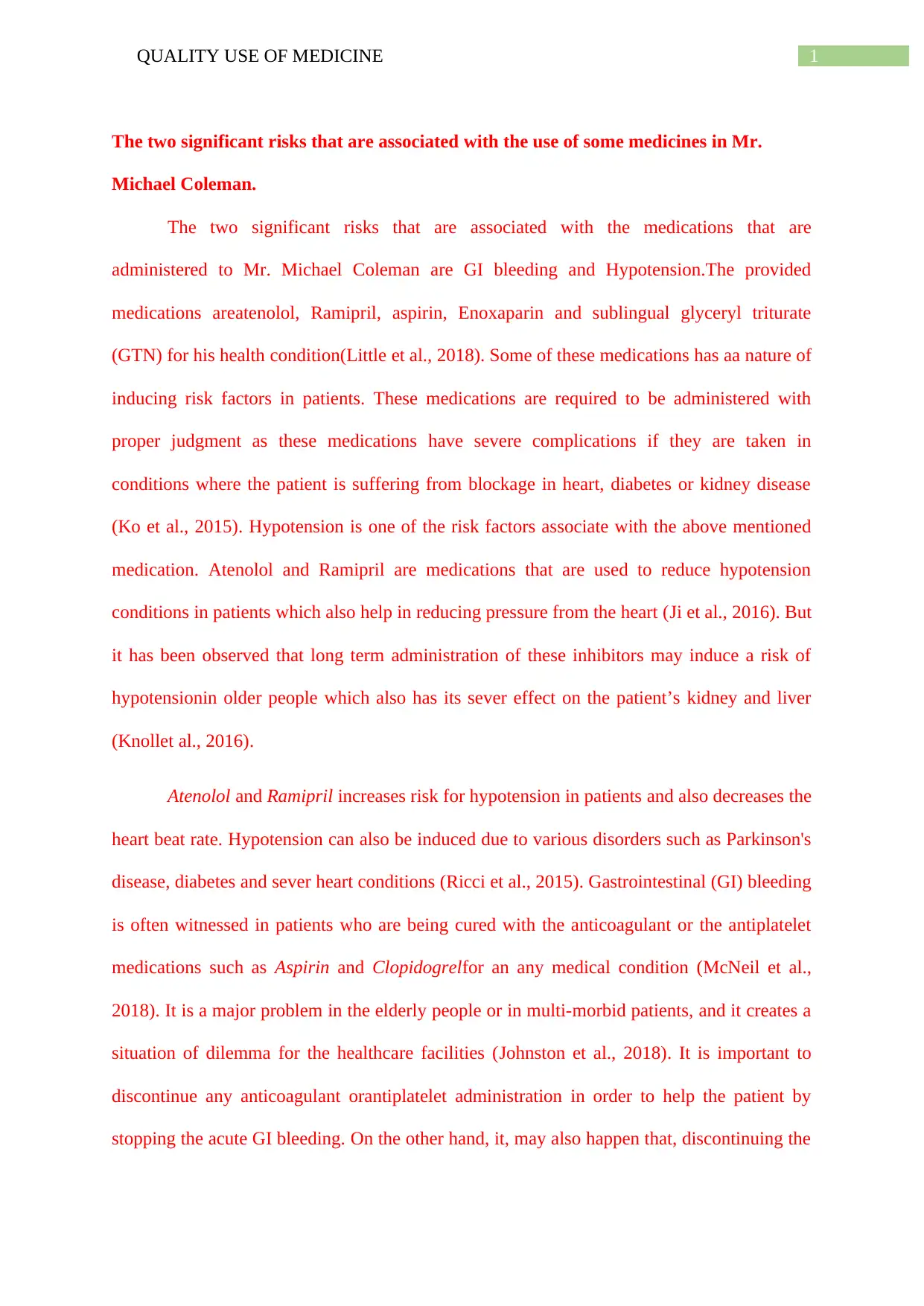
1QUALITY USE OF MEDICINE
The two significant risks that are associated with the use of some medicines in Mr.
Michael Coleman.
The two significant risks that are associated with the medications that are
administered to Mr. Michael Coleman are GI bleeding and Hypotension.The provided
medications areatenolol, Ramipril, aspirin, Enoxaparin and sublingual glyceryl triturate
(GTN) for his health condition(Little et al., 2018). Some of these medications has aa nature of
inducing risk factors in patients. These medications are required to be administered with
proper judgment as these medications have severe complications if they are taken in
conditions where the patient is suffering from blockage in heart, diabetes or kidney disease
(Ko et al., 2015). Hypotension is one of the risk factors associate with the above mentioned
medication. Atenolol and Ramipril are medications that are used to reduce hypotension
conditions in patients which also help in reducing pressure from the heart (Ji et al., 2016). But
it has been observed that long term administration of these inhibitors may induce a risk of
hypotensionin older people which also has its sever effect on the patient’s kidney and liver
(Knollet al., 2016).
Atenolol and Ramipril increases risk for hypotension in patients and also decreases the
heart beat rate. Hypotension can also be induced due to various disorders such as Parkinson's
disease, diabetes and sever heart conditions (Ricci et al., 2015). Gastrointestinal (GI) bleeding
is often witnessed in patients who are being cured with the anticoagulant or the antiplatelet
medications such as Aspirin and Clopidogrelfor an any medical condition (McNeil et al.,
2018). It is a major problem in the elderly people or in multi-morbid patients, and it creates a
situation of dilemma for the healthcare facilities (Johnston et al., 2018). It is important to
discontinue any anticoagulant orantiplatelet administration in order to help the patient by
stopping the acute GI bleeding. On the other hand, it, may also happen that, discontinuing the
The two significant risks that are associated with the use of some medicines in Mr.
Michael Coleman.
The two significant risks that are associated with the medications that are
administered to Mr. Michael Coleman are GI bleeding and Hypotension.The provided
medications areatenolol, Ramipril, aspirin, Enoxaparin and sublingual glyceryl triturate
(GTN) for his health condition(Little et al., 2018). Some of these medications has aa nature of
inducing risk factors in patients. These medications are required to be administered with
proper judgment as these medications have severe complications if they are taken in
conditions where the patient is suffering from blockage in heart, diabetes or kidney disease
(Ko et al., 2015). Hypotension is one of the risk factors associate with the above mentioned
medication. Atenolol and Ramipril are medications that are used to reduce hypotension
conditions in patients which also help in reducing pressure from the heart (Ji et al., 2016). But
it has been observed that long term administration of these inhibitors may induce a risk of
hypotensionin older people which also has its sever effect on the patient’s kidney and liver
(Knollet al., 2016).
Atenolol and Ramipril increases risk for hypotension in patients and also decreases the
heart beat rate. Hypotension can also be induced due to various disorders such as Parkinson's
disease, diabetes and sever heart conditions (Ricci et al., 2015). Gastrointestinal (GI) bleeding
is often witnessed in patients who are being cured with the anticoagulant or the antiplatelet
medications such as Aspirin and Clopidogrelfor an any medical condition (McNeil et al.,
2018). It is a major problem in the elderly people or in multi-morbid patients, and it creates a
situation of dilemma for the healthcare facilities (Johnston et al., 2018). It is important to
discontinue any anticoagulant orantiplatelet administration in order to help the patient by
stopping the acute GI bleeding. On the other hand, it, may also happen that, discontinuing the
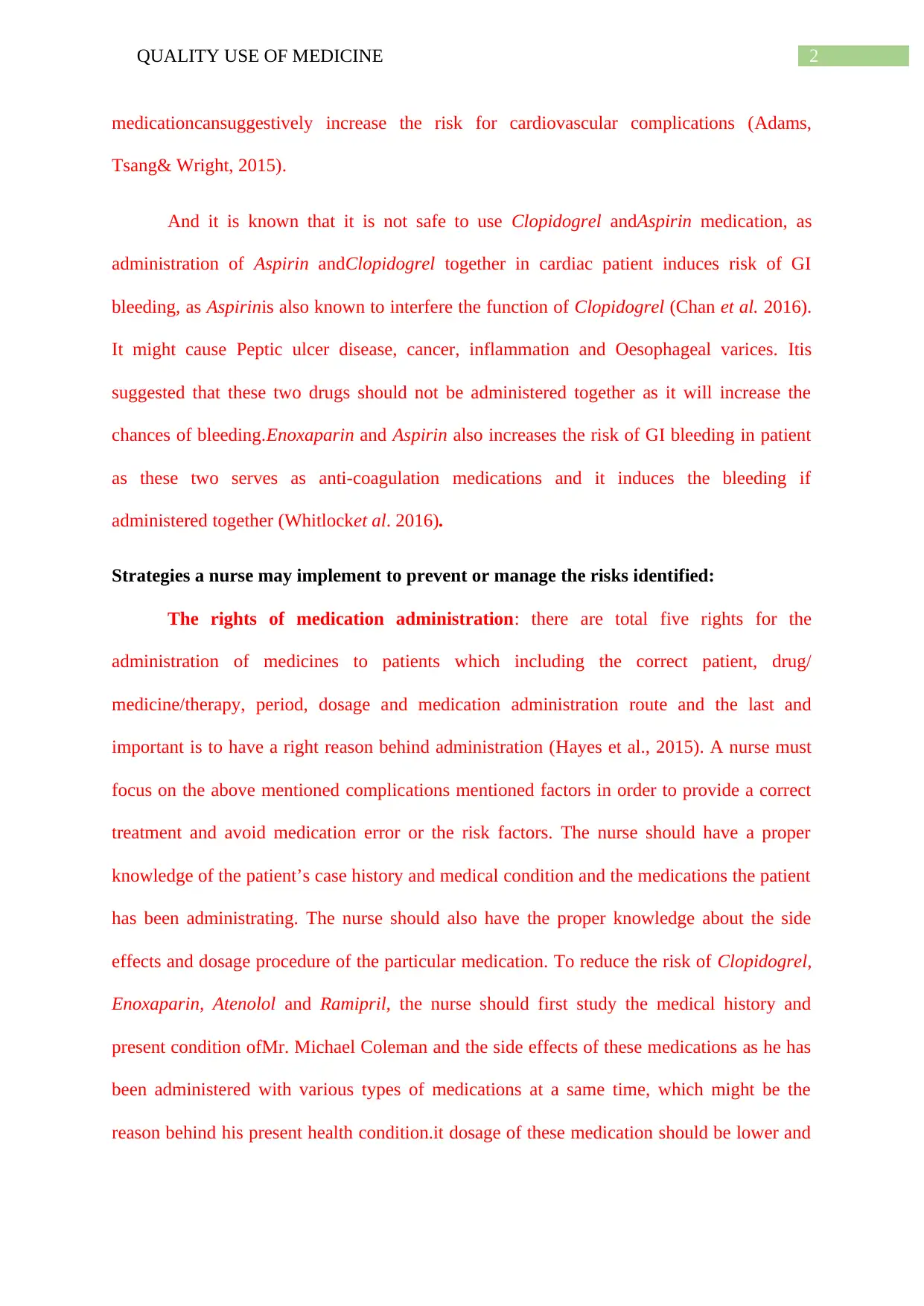
2QUALITY USE OF MEDICINE
medicationcansuggestively increase the risk for cardiovascular complications (Adams,
Tsang& Wright, 2015).
And it is known that it is not safe to use Clopidogrel andAspirin medication, as
administration of Aspirin andClopidogrel together in cardiac patient induces risk of GI
bleeding, as Aspirinis also known to interfere the function of Clopidogrel (Chan et al. 2016).
It might cause Peptic ulcer disease, cancer, inflammation and Oesophageal varices. Itis
suggested that these two drugs should not be administered together as it will increase the
chances of bleeding.Enoxaparin and Aspirin also increases the risk of GI bleeding in patient
as these two serves as anti-coagulation medications and it induces the bleeding if
administered together (Whitlocket al. 2016).
Strategies a nurse may implement to prevent or manage the risks identified:
The rights of medication administration: there are total five rights for the
administration of medicines to patients which including the correct patient, drug/
medicine/therapy, period, dosage and medication administration route and the last and
important is to have a right reason behind administration (Hayes et al., 2015). A nurse must
focus on the above mentioned complications mentioned factors in order to provide a correct
treatment and avoid medication error or the risk factors. The nurse should have a proper
knowledge of the patient’s case history and medical condition and the medications the patient
has been administrating. The nurse should also have the proper knowledge about the side
effects and dosage procedure of the particular medication. To reduce the risk of Clopidogrel,
Enoxaparin, Atenolol and Ramipril, the nurse should first study the medical history and
present condition ofMr. Michael Coleman and the side effects of these medications as he has
been administered with various types of medications at a same time, which might be the
reason behind his present health condition.it dosage of these medication should be lower and
medicationcansuggestively increase the risk for cardiovascular complications (Adams,
Tsang& Wright, 2015).
And it is known that it is not safe to use Clopidogrel andAspirin medication, as
administration of Aspirin andClopidogrel together in cardiac patient induces risk of GI
bleeding, as Aspirinis also known to interfere the function of Clopidogrel (Chan et al. 2016).
It might cause Peptic ulcer disease, cancer, inflammation and Oesophageal varices. Itis
suggested that these two drugs should not be administered together as it will increase the
chances of bleeding.Enoxaparin and Aspirin also increases the risk of GI bleeding in patient
as these two serves as anti-coagulation medications and it induces the bleeding if
administered together (Whitlocket al. 2016).
Strategies a nurse may implement to prevent or manage the risks identified:
The rights of medication administration: there are total five rights for the
administration of medicines to patients which including the correct patient, drug/
medicine/therapy, period, dosage and medication administration route and the last and
important is to have a right reason behind administration (Hayes et al., 2015). A nurse must
focus on the above mentioned complications mentioned factors in order to provide a correct
treatment and avoid medication error or the risk factors. The nurse should have a proper
knowledge of the patient’s case history and medical condition and the medications the patient
has been administrating. The nurse should also have the proper knowledge about the side
effects and dosage procedure of the particular medication. To reduce the risk of Clopidogrel,
Enoxaparin, Atenolol and Ramipril, the nurse should first study the medical history and
present condition ofMr. Michael Coleman and the side effects of these medications as he has
been administered with various types of medications at a same time, which might be the
reason behind his present health condition.it dosage of these medication should be lower and
⊘ This is a preview!⊘
Do you want full access?
Subscribe today to unlock all pages.

Trusted by 1+ million students worldwide
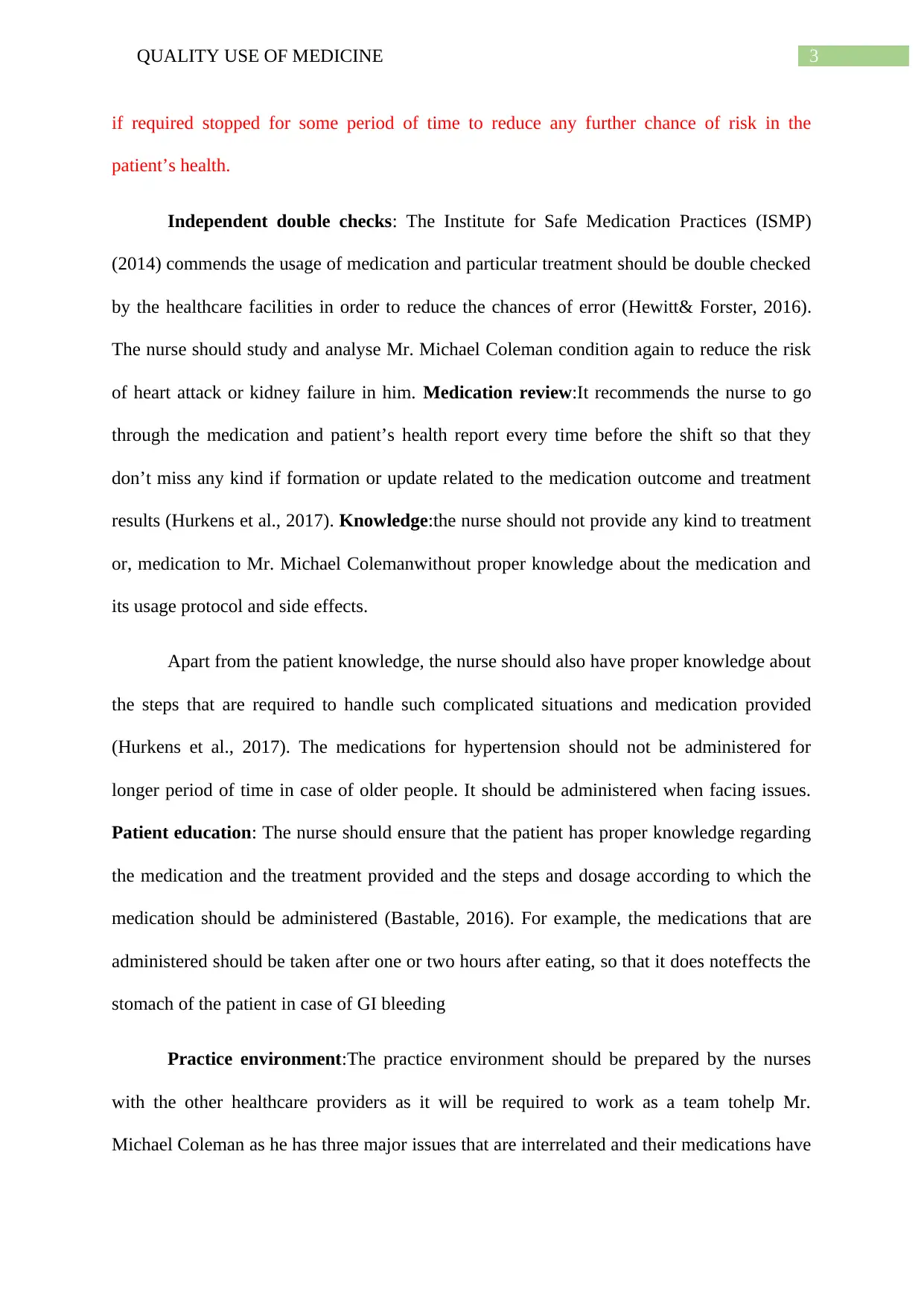
3QUALITY USE OF MEDICINE
if required stopped for some period of time to reduce any further chance of risk in the
patient’s health.
Independent double checks: The Institute for Safe Medication Practices (ISMP)
(2014) commends the usage of medication and particular treatment should be double checked
by the healthcare facilities in order to reduce the chances of error (Hewitt& Forster, 2016).
The nurse should study and analyse Mr. Michael Coleman condition again to reduce the risk
of heart attack or kidney failure in him. Medication review:It recommends the nurse to go
through the medication and patient’s health report every time before the shift so that they
don’t miss any kind if formation or update related to the medication outcome and treatment
results (Hurkens et al., 2017). Knowledge:the nurse should not provide any kind to treatment
or, medication to Mr. Michael Colemanwithout proper knowledge about the medication and
its usage protocol and side effects.
Apart from the patient knowledge, the nurse should also have proper knowledge about
the steps that are required to handle such complicated situations and medication provided
(Hurkens et al., 2017). The medications for hypertension should not be administered for
longer period of time in case of older people. It should be administered when facing issues.
Patient education: The nurse should ensure that the patient has proper knowledge regarding
the medication and the treatment provided and the steps and dosage according to which the
medication should be administered (Bastable, 2016). For example, the medications that are
administered should be taken after one or two hours after eating, so that it does noteffects the
stomach of the patient in case of GI bleeding
Practice environment:The practice environment should be prepared by the nurses
with the other healthcare providers as it will be required to work as a team tohelp Mr.
Michael Coleman as he has three major issues that are interrelated and their medications have
if required stopped for some period of time to reduce any further chance of risk in the
patient’s health.
Independent double checks: The Institute for Safe Medication Practices (ISMP)
(2014) commends the usage of medication and particular treatment should be double checked
by the healthcare facilities in order to reduce the chances of error (Hewitt& Forster, 2016).
The nurse should study and analyse Mr. Michael Coleman condition again to reduce the risk
of heart attack or kidney failure in him. Medication review:It recommends the nurse to go
through the medication and patient’s health report every time before the shift so that they
don’t miss any kind if formation or update related to the medication outcome and treatment
results (Hurkens et al., 2017). Knowledge:the nurse should not provide any kind to treatment
or, medication to Mr. Michael Colemanwithout proper knowledge about the medication and
its usage protocol and side effects.
Apart from the patient knowledge, the nurse should also have proper knowledge about
the steps that are required to handle such complicated situations and medication provided
(Hurkens et al., 2017). The medications for hypertension should not be administered for
longer period of time in case of older people. It should be administered when facing issues.
Patient education: The nurse should ensure that the patient has proper knowledge regarding
the medication and the treatment provided and the steps and dosage according to which the
medication should be administered (Bastable, 2016). For example, the medications that are
administered should be taken after one or two hours after eating, so that it does noteffects the
stomach of the patient in case of GI bleeding
Practice environment:The practice environment should be prepared by the nurses
with the other healthcare providers as it will be required to work as a team tohelp Mr.
Michael Coleman as he has three major issues that are interrelated and their medications have
Paraphrase This Document
Need a fresh take? Get an instant paraphrase of this document with our AI Paraphraser
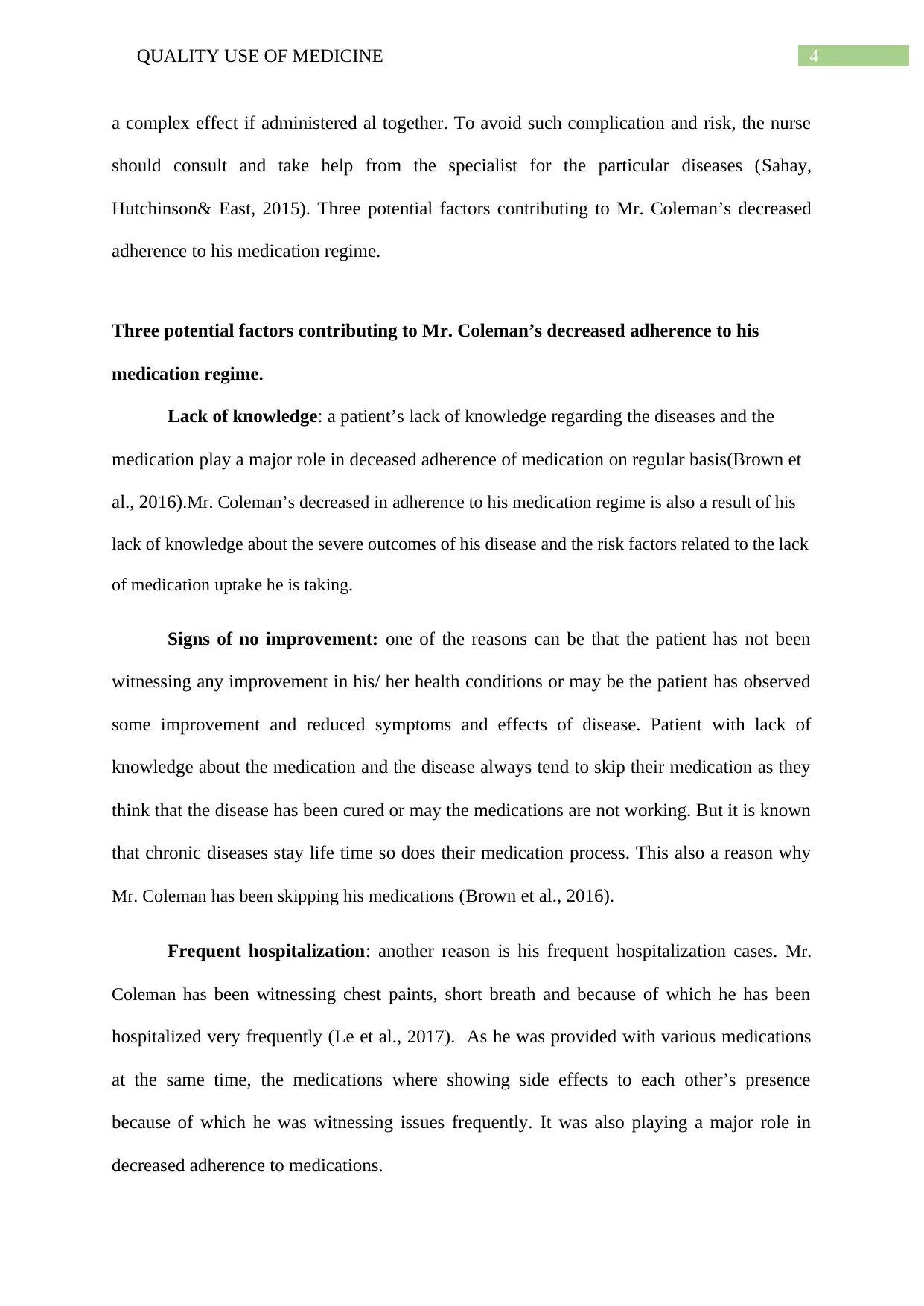
4QUALITY USE OF MEDICINE
a complex effect if administered al together. To avoid such complication and risk, the nurse
should consult and take help from the specialist for the particular diseases (Sahay,
Hutchinson& East, 2015). Three potential factors contributing to Mr. Coleman’s decreased
adherence to his medication regime.
Three potential factors contributing to Mr. Coleman’s decreased adherence to his
medication regime.
Lack of knowledge: a patient’s lack of knowledge regarding the diseases and the
medication play a major role in deceased adherence of medication on regular basis(Brown et
al., 2016).Mr. Coleman’s decreased in adherence to his medication regime is also a result of his
lack of knowledge about the severe outcomes of his disease and the risk factors related to the lack
of medication uptake he is taking.
Signs of no improvement: one of the reasons can be that the patient has not been
witnessing any improvement in his/ her health conditions or may be the patient has observed
some improvement and reduced symptoms and effects of disease. Patient with lack of
knowledge about the medication and the disease always tend to skip their medication as they
think that the disease has been cured or may the medications are not working. But it is known
that chronic diseases stay life time so does their medication process. This also a reason why
Mr. Coleman has been skipping his medications (Brown et al., 2016).
Frequent hospitalization: another reason is his frequent hospitalization cases. Mr.
Coleman has been witnessing chest paints, short breath and because of which he has been
hospitalized very frequently (Le et al., 2017). As he was provided with various medications
at the same time, the medications where showing side effects to each other’s presence
because of which he was witnessing issues frequently. It was also playing a major role in
decreased adherence to medications.
a complex effect if administered al together. To avoid such complication and risk, the nurse
should consult and take help from the specialist for the particular diseases (Sahay,
Hutchinson& East, 2015). Three potential factors contributing to Mr. Coleman’s decreased
adherence to his medication regime.
Three potential factors contributing to Mr. Coleman’s decreased adherence to his
medication regime.
Lack of knowledge: a patient’s lack of knowledge regarding the diseases and the
medication play a major role in deceased adherence of medication on regular basis(Brown et
al., 2016).Mr. Coleman’s decreased in adherence to his medication regime is also a result of his
lack of knowledge about the severe outcomes of his disease and the risk factors related to the lack
of medication uptake he is taking.
Signs of no improvement: one of the reasons can be that the patient has not been
witnessing any improvement in his/ her health conditions or may be the patient has observed
some improvement and reduced symptoms and effects of disease. Patient with lack of
knowledge about the medication and the disease always tend to skip their medication as they
think that the disease has been cured or may the medications are not working. But it is known
that chronic diseases stay life time so does their medication process. This also a reason why
Mr. Coleman has been skipping his medications (Brown et al., 2016).
Frequent hospitalization: another reason is his frequent hospitalization cases. Mr.
Coleman has been witnessing chest paints, short breath and because of which he has been
hospitalized very frequently (Le et al., 2017). As he was provided with various medications
at the same time, the medications where showing side effects to each other’s presence
because of which he was witnessing issues frequently. It was also playing a major role in
decreased adherence to medications.
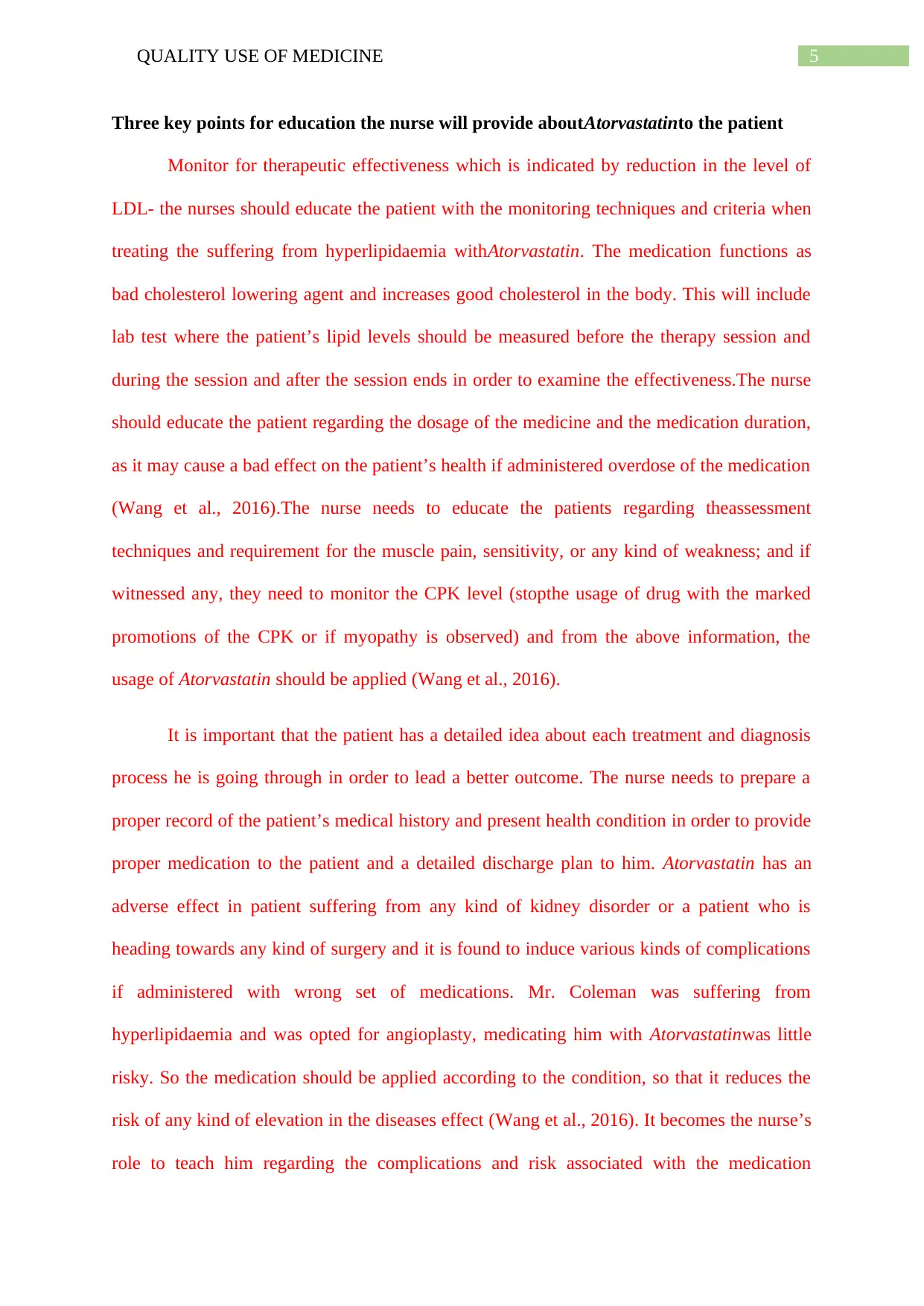
5QUALITY USE OF MEDICINE
Three key points for education the nurse will provide aboutAtorvastatinto the patient
Monitor for therapeutic effectiveness which is indicated by reduction in the level of
LDL- the nurses should educate the patient with the monitoring techniques and criteria when
treating the suffering from hyperlipidaemia withAtorvastatin. The medication functions as
bad cholesterol lowering agent and increases good cholesterol in the body. This will include
lab test where the patient’s lipid levels should be measured before the therapy session and
during the session and after the session ends in order to examine the effectiveness.The nurse
should educate the patient regarding the dosage of the medicine and the medication duration,
as it may cause a bad effect on the patient’s health if administered overdose of the medication
(Wang et al., 2016).The nurse needs to educate the patients regarding theassessment
techniques and requirement for the muscle pain, sensitivity, or any kind of weakness; and if
witnessed any, they need to monitor the CPK level (stopthe usage of drug with the marked
promotions of the CPK or if myopathy is observed) and from the above information, the
usage of Atorvastatin should be applied (Wang et al., 2016).
It is important that the patient has a detailed idea about each treatment and diagnosis
process he is going through in order to lead a better outcome. The nurse needs to prepare a
proper record of the patient’s medical history and present health condition in order to provide
proper medication to the patient and a detailed discharge plan to him. Atorvastatin has an
adverse effect in patient suffering from any kind of kidney disorder or a patient who is
heading towards any kind of surgery and it is found to induce various kinds of complications
if administered with wrong set of medications. Mr. Coleman was suffering from
hyperlipidaemia and was opted for angioplasty, medicating him with Atorvastatinwas little
risky. So the medication should be applied according to the condition, so that it reduces the
risk of any kind of elevation in the diseases effect (Wang et al., 2016). It becomes the nurse’s
role to teach him regarding the complications and risk associated with the medication
Three key points for education the nurse will provide aboutAtorvastatinto the patient
Monitor for therapeutic effectiveness which is indicated by reduction in the level of
LDL- the nurses should educate the patient with the monitoring techniques and criteria when
treating the suffering from hyperlipidaemia withAtorvastatin. The medication functions as
bad cholesterol lowering agent and increases good cholesterol in the body. This will include
lab test where the patient’s lipid levels should be measured before the therapy session and
during the session and after the session ends in order to examine the effectiveness.The nurse
should educate the patient regarding the dosage of the medicine and the medication duration,
as it may cause a bad effect on the patient’s health if administered overdose of the medication
(Wang et al., 2016).The nurse needs to educate the patients regarding theassessment
techniques and requirement for the muscle pain, sensitivity, or any kind of weakness; and if
witnessed any, they need to monitor the CPK level (stopthe usage of drug with the marked
promotions of the CPK or if myopathy is observed) and from the above information, the
usage of Atorvastatin should be applied (Wang et al., 2016).
It is important that the patient has a detailed idea about each treatment and diagnosis
process he is going through in order to lead a better outcome. The nurse needs to prepare a
proper record of the patient’s medical history and present health condition in order to provide
proper medication to the patient and a detailed discharge plan to him. Atorvastatin has an
adverse effect in patient suffering from any kind of kidney disorder or a patient who is
heading towards any kind of surgery and it is found to induce various kinds of complications
if administered with wrong set of medications. Mr. Coleman was suffering from
hyperlipidaemia and was opted for angioplasty, medicating him with Atorvastatinwas little
risky. So the medication should be applied according to the condition, so that it reduces the
risk of any kind of elevation in the diseases effect (Wang et al., 2016). It becomes the nurse’s
role to teach him regarding the complications and risk associated with the medication
⊘ This is a preview!⊘
Do you want full access?
Subscribe today to unlock all pages.

Trusted by 1+ million students worldwide

6QUALITY USE OF MEDICINE
administration. The nurse should also guide him regarding the clinical visits and the time
duration of the visits.
administration. The nurse should also guide him regarding the clinical visits and the time
duration of the visits.
Paraphrase This Document
Need a fresh take? Get an instant paraphrase of this document with our AI Paraphraser
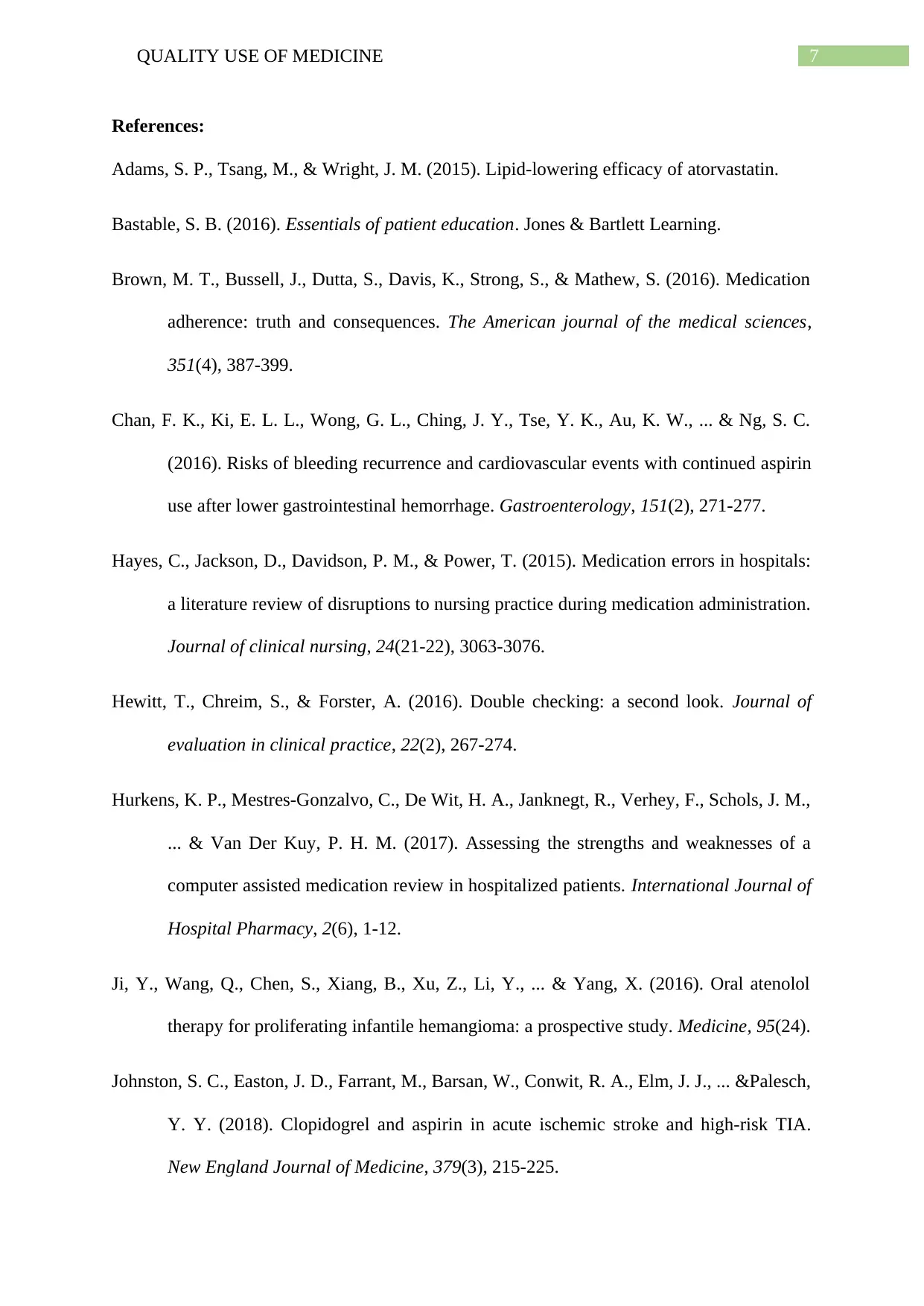
7QUALITY USE OF MEDICINE
References:
Adams, S. P., Tsang, M., & Wright, J. M. (2015). Lipid-lowering efficacy of atorvastatin.
Bastable, S. B. (2016). Essentials of patient education. Jones & Bartlett Learning.
Brown, M. T., Bussell, J., Dutta, S., Davis, K., Strong, S., & Mathew, S. (2016). Medication
adherence: truth and consequences. The American journal of the medical sciences,
351(4), 387-399.
Chan, F. K., Ki, E. L. L., Wong, G. L., Ching, J. Y., Tse, Y. K., Au, K. W., ... & Ng, S. C.
(2016). Risks of bleeding recurrence and cardiovascular events with continued aspirin
use after lower gastrointestinal hemorrhage. Gastroenterology, 151(2), 271-277.
Hayes, C., Jackson, D., Davidson, P. M., & Power, T. (2015). Medication errors in hospitals:
a literature review of disruptions to nursing practice during medication administration.
Journal of clinical nursing, 24(21-22), 3063-3076.
Hewitt, T., Chreim, S., & Forster, A. (2016). Double checking: a second look. Journal of
evaluation in clinical practice, 22(2), 267-274.
Hurkens, K. P., Mestres-Gonzalvo, C., De Wit, H. A., Janknegt, R., Verhey, F., Schols, J. M.,
... & Van Der Kuy, P. H. M. (2017). Assessing the strengths and weaknesses of a
computer assisted medication review in hospitalized patients. International Journal of
Hospital Pharmacy, 2(6), 1-12.
Ji, Y., Wang, Q., Chen, S., Xiang, B., Xu, Z., Li, Y., ... & Yang, X. (2016). Oral atenolol
therapy for proliferating infantile hemangioma: a prospective study. Medicine, 95(24).
Johnston, S. C., Easton, J. D., Farrant, M., Barsan, W., Conwit, R. A., Elm, J. J., ... &Palesch,
Y. Y. (2018). Clopidogrel and aspirin in acute ischemic stroke and high-risk TIA.
New England Journal of Medicine, 379(3), 215-225.
References:
Adams, S. P., Tsang, M., & Wright, J. M. (2015). Lipid-lowering efficacy of atorvastatin.
Bastable, S. B. (2016). Essentials of patient education. Jones & Bartlett Learning.
Brown, M. T., Bussell, J., Dutta, S., Davis, K., Strong, S., & Mathew, S. (2016). Medication
adherence: truth and consequences. The American journal of the medical sciences,
351(4), 387-399.
Chan, F. K., Ki, E. L. L., Wong, G. L., Ching, J. Y., Tse, Y. K., Au, K. W., ... & Ng, S. C.
(2016). Risks of bleeding recurrence and cardiovascular events with continued aspirin
use after lower gastrointestinal hemorrhage. Gastroenterology, 151(2), 271-277.
Hayes, C., Jackson, D., Davidson, P. M., & Power, T. (2015). Medication errors in hospitals:
a literature review of disruptions to nursing practice during medication administration.
Journal of clinical nursing, 24(21-22), 3063-3076.
Hewitt, T., Chreim, S., & Forster, A. (2016). Double checking: a second look. Journal of
evaluation in clinical practice, 22(2), 267-274.
Hurkens, K. P., Mestres-Gonzalvo, C., De Wit, H. A., Janknegt, R., Verhey, F., Schols, J. M.,
... & Van Der Kuy, P. H. M. (2017). Assessing the strengths and weaknesses of a
computer assisted medication review in hospitalized patients. International Journal of
Hospital Pharmacy, 2(6), 1-12.
Ji, Y., Wang, Q., Chen, S., Xiang, B., Xu, Z., Li, Y., ... & Yang, X. (2016). Oral atenolol
therapy for proliferating infantile hemangioma: a prospective study. Medicine, 95(24).
Johnston, S. C., Easton, J. D., Farrant, M., Barsan, W., Conwit, R. A., Elm, J. J., ... &Palesch,
Y. Y. (2018). Clopidogrel and aspirin in acute ischemic stroke and high-risk TIA.
New England Journal of Medicine, 379(3), 215-225.
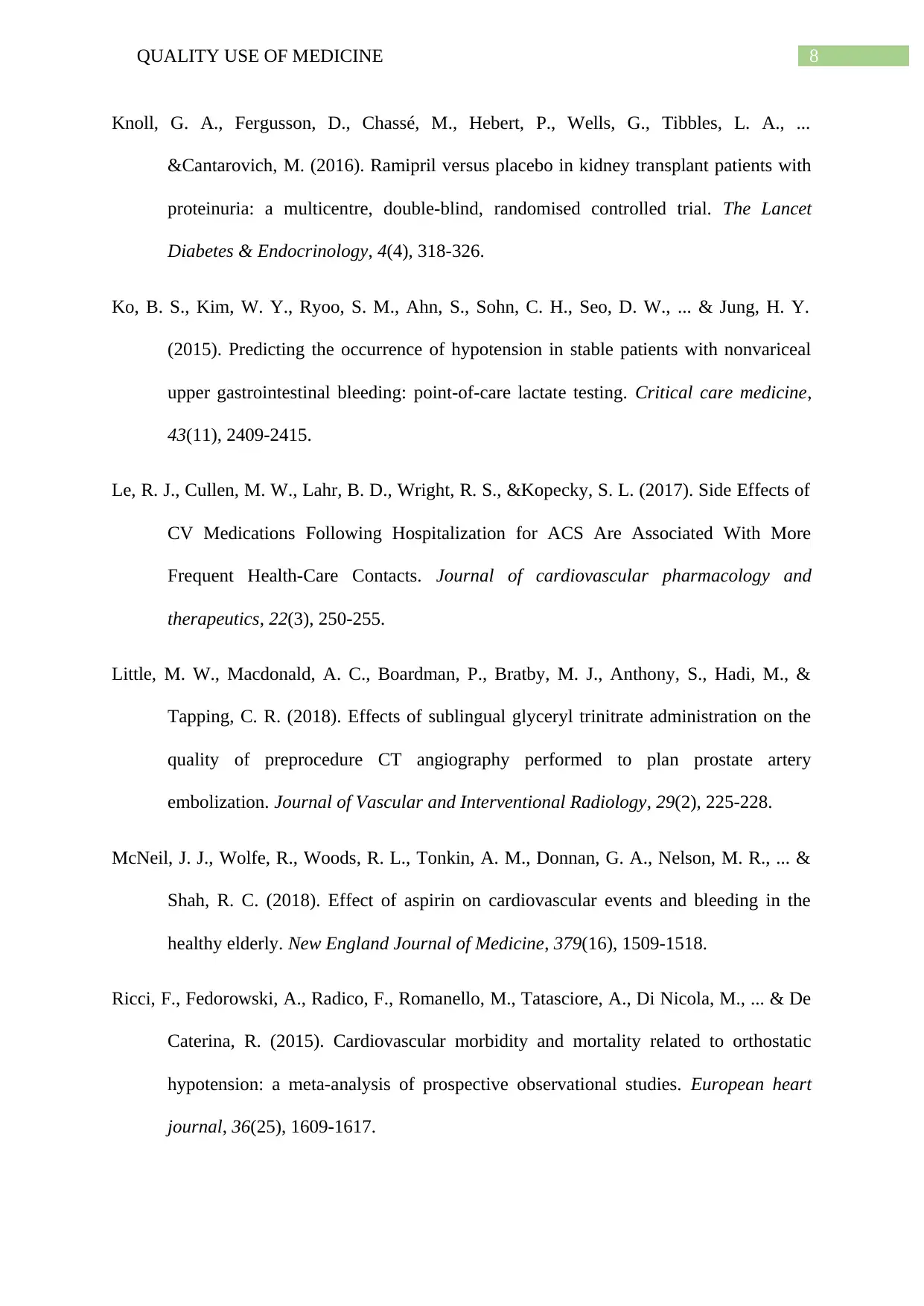
8QUALITY USE OF MEDICINE
Knoll, G. A., Fergusson, D., Chassé, M., Hebert, P., Wells, G., Tibbles, L. A., ...
&Cantarovich, M. (2016). Ramipril versus placebo in kidney transplant patients with
proteinuria: a multicentre, double-blind, randomised controlled trial. The Lancet
Diabetes & Endocrinology, 4(4), 318-326.
Ko, B. S., Kim, W. Y., Ryoo, S. M., Ahn, S., Sohn, C. H., Seo, D. W., ... & Jung, H. Y.
(2015). Predicting the occurrence of hypotension in stable patients with nonvariceal
upper gastrointestinal bleeding: point-of-care lactate testing. Critical care medicine,
43(11), 2409-2415.
Le, R. J., Cullen, M. W., Lahr, B. D., Wright, R. S., &Kopecky, S. L. (2017). Side Effects of
CV Medications Following Hospitalization for ACS Are Associated With More
Frequent Health-Care Contacts. Journal of cardiovascular pharmacology and
therapeutics, 22(3), 250-255.
Little, M. W., Macdonald, A. C., Boardman, P., Bratby, M. J., Anthony, S., Hadi, M., &
Tapping, C. R. (2018). Effects of sublingual glyceryl trinitrate administration on the
quality of preprocedure CT angiography performed to plan prostate artery
embolization. Journal of Vascular and Interventional Radiology, 29(2), 225-228.
McNeil, J. J., Wolfe, R., Woods, R. L., Tonkin, A. M., Donnan, G. A., Nelson, M. R., ... &
Shah, R. C. (2018). Effect of aspirin on cardiovascular events and bleeding in the
healthy elderly. New England Journal of Medicine, 379(16), 1509-1518.
Ricci, F., Fedorowski, A., Radico, F., Romanello, M., Tatasciore, A., Di Nicola, M., ... & De
Caterina, R. (2015). Cardiovascular morbidity and mortality related to orthostatic
hypotension: a meta-analysis of prospective observational studies. European heart
journal, 36(25), 1609-1617.
Knoll, G. A., Fergusson, D., Chassé, M., Hebert, P., Wells, G., Tibbles, L. A., ...
&Cantarovich, M. (2016). Ramipril versus placebo in kidney transplant patients with
proteinuria: a multicentre, double-blind, randomised controlled trial. The Lancet
Diabetes & Endocrinology, 4(4), 318-326.
Ko, B. S., Kim, W. Y., Ryoo, S. M., Ahn, S., Sohn, C. H., Seo, D. W., ... & Jung, H. Y.
(2015). Predicting the occurrence of hypotension in stable patients with nonvariceal
upper gastrointestinal bleeding: point-of-care lactate testing. Critical care medicine,
43(11), 2409-2415.
Le, R. J., Cullen, M. W., Lahr, B. D., Wright, R. S., &Kopecky, S. L. (2017). Side Effects of
CV Medications Following Hospitalization for ACS Are Associated With More
Frequent Health-Care Contacts. Journal of cardiovascular pharmacology and
therapeutics, 22(3), 250-255.
Little, M. W., Macdonald, A. C., Boardman, P., Bratby, M. J., Anthony, S., Hadi, M., &
Tapping, C. R. (2018). Effects of sublingual glyceryl trinitrate administration on the
quality of preprocedure CT angiography performed to plan prostate artery
embolization. Journal of Vascular and Interventional Radiology, 29(2), 225-228.
McNeil, J. J., Wolfe, R., Woods, R. L., Tonkin, A. M., Donnan, G. A., Nelson, M. R., ... &
Shah, R. C. (2018). Effect of aspirin on cardiovascular events and bleeding in the
healthy elderly. New England Journal of Medicine, 379(16), 1509-1518.
Ricci, F., Fedorowski, A., Radico, F., Romanello, M., Tatasciore, A., Di Nicola, M., ... & De
Caterina, R. (2015). Cardiovascular morbidity and mortality related to orthostatic
hypotension: a meta-analysis of prospective observational studies. European heart
journal, 36(25), 1609-1617.
⊘ This is a preview!⊘
Do you want full access?
Subscribe today to unlock all pages.

Trusted by 1+ million students worldwide
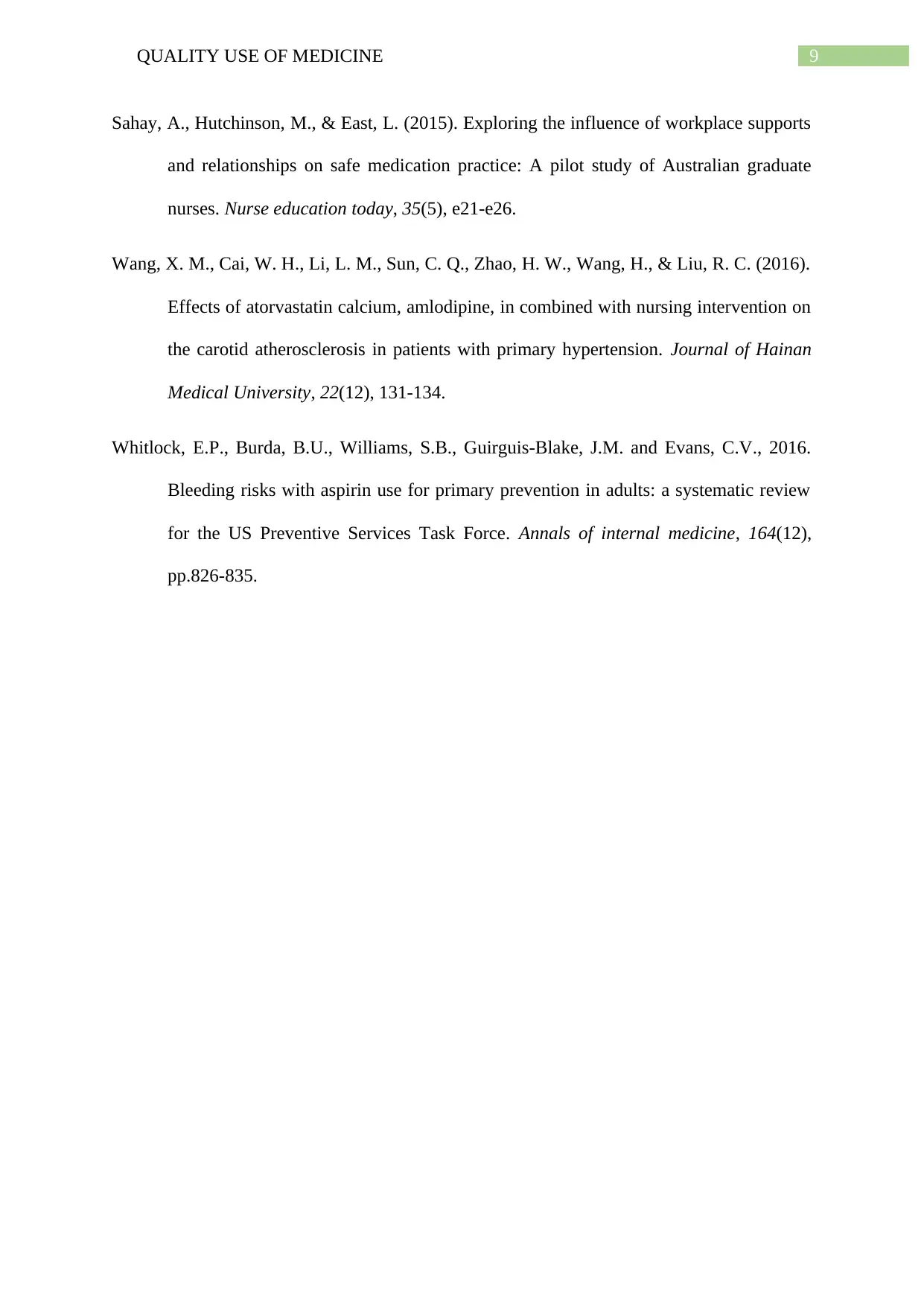
9QUALITY USE OF MEDICINE
Sahay, A., Hutchinson, M., & East, L. (2015). Exploring the influence of workplace supports
and relationships on safe medication practice: A pilot study of Australian graduate
nurses. Nurse education today, 35(5), e21-e26.
Wang, X. M., Cai, W. H., Li, L. M., Sun, C. Q., Zhao, H. W., Wang, H., & Liu, R. C. (2016).
Effects of atorvastatin calcium, amlodipine, in combined with nursing intervention on
the carotid atherosclerosis in patients with primary hypertension. Journal of Hainan
Medical University, 22(12), 131-134.
Whitlock, E.P., Burda, B.U., Williams, S.B., Guirguis-Blake, J.M. and Evans, C.V., 2016.
Bleeding risks with aspirin use for primary prevention in adults: a systematic review
for the US Preventive Services Task Force. Annals of internal medicine, 164(12),
pp.826-835.
Sahay, A., Hutchinson, M., & East, L. (2015). Exploring the influence of workplace supports
and relationships on safe medication practice: A pilot study of Australian graduate
nurses. Nurse education today, 35(5), e21-e26.
Wang, X. M., Cai, W. H., Li, L. M., Sun, C. Q., Zhao, H. W., Wang, H., & Liu, R. C. (2016).
Effects of atorvastatin calcium, amlodipine, in combined with nursing intervention on
the carotid atherosclerosis in patients with primary hypertension. Journal of Hainan
Medical University, 22(12), 131-134.
Whitlock, E.P., Burda, B.U., Williams, S.B., Guirguis-Blake, J.M. and Evans, C.V., 2016.
Bleeding risks with aspirin use for primary prevention in adults: a systematic review
for the US Preventive Services Task Force. Annals of internal medicine, 164(12),
pp.826-835.
1 out of 10
Related Documents
Your All-in-One AI-Powered Toolkit for Academic Success.
+13062052269
info@desklib.com
Available 24*7 on WhatsApp / Email
![[object Object]](/_next/static/media/star-bottom.7253800d.svg)
Unlock your academic potential
Copyright © 2020–2025 A2Z Services. All Rights Reserved. Developed and managed by ZUCOL.





